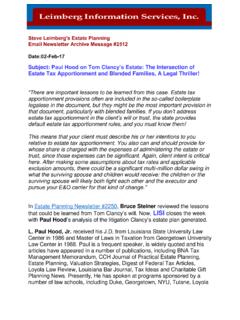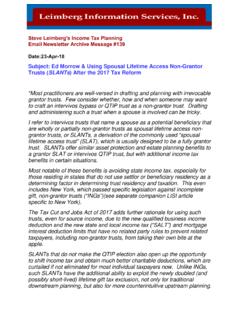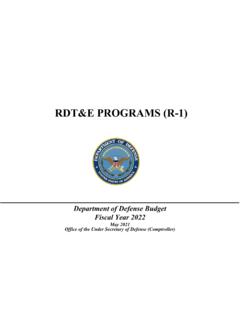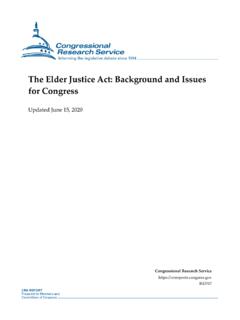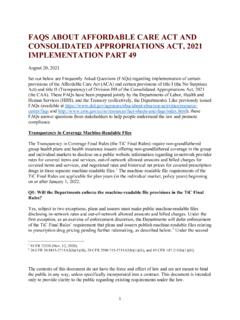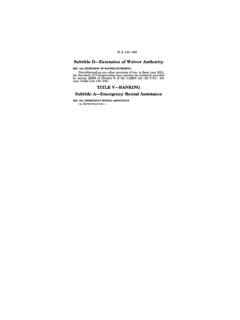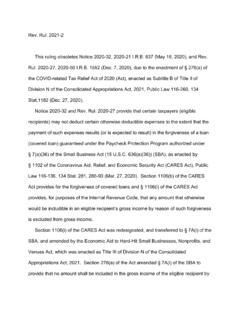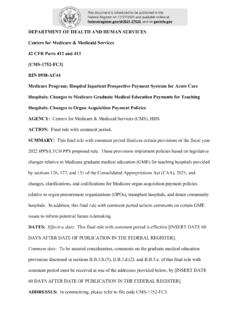Transcription of Natalie Choate: The SECURE Act - leimbergservices.com
1 Natalie choate : The SECURE Act Signed into law December 20, 2019, SECURE has radically changed the estate planning landscape for clients retirement benefits. Except for a few types of beneficiaries, the life expectancy payout is gone with the wind, replaced by a maximum 10-year post-death payout period for most retirement benefits. Here is what estate planners need to know about the new RMD regime, including what we don t yet know, and what to do about it all. Natalie choate provides members with her analysis of the SECURE Act. Members will find her commentary most helpful as it contains a Practitioner to Do List as well as commentary that examines what advisors need to do now given the radically new landscape we now operate in. Natalie B. choate is a lawyer with Nutter McClennen & Fish LLP in Boston, and is the author of the estate planner s bible on estate and distribution planning for our clients IRAs and other retirement plans, Life and Death Planning for Retirement Benefits.
2 The 8th edition (2019) can be ordered at , where a downloadable supplement updating the book for the SECURE Act changes will be posted free as soon as feasible. Or subscribe right now to the electronic edition at Here is Natalie s commentary: EXECUTIVE SUMMARY: For over 30 years, the go-to estate plan for the owners of tax-favored retirement plans has been the stretch IRA : Make your IRA or other retirement plan payable to a designated beneficiary (or see-through trust) and the designated beneficiary (or trust) could leave the plan in its ! "#$% & '()*& *$+ 2 tax-deferred status for years or decades after your death, withdrawing the benefits only gradually by taking annual distributions over his or her life expectancy. With the life expectancy of a 50-year-old son or daughter being years, or that of a grandchild or great-grandchild being potentially as long as 80 years, this estate plan was understandably popular.
3 SECURE has swept that option away for most people. The definition of designated beneficiary hasn t changed. The definition of see-through trust hasn t changed. What has changed is the payout period for those beneficiaries: With the exception of five particular types of beneficiaries ( eligible designated beneficiaries ) (EDB), the life expectancy payout has been replaced by a 10-year payout rule. So, the 50-year old son or daughter who inherits Mom s IRA will now have to withdraw the entire account within 10 years after Mom s death instead of over the life expectancy payout period that would have applied if Mom had died before 2020. But even pre-2020 deaths are not totally spared by SECURE ; they get only a partial exemption from the 10-year payout rule. See SECURE Effective Date; Pre-2020 Deaths, below. The rest of this newsletter will examine the new SECURE regime, how it works, who it applies to, which beneficiaries are exempt, what we still don t know, and what estate planners need to do about all this.
4 COMMENT: CONTENTS Meet SECURE ; Where to Find the Law; Terminology .. 3 The Old Rules, Still Partially in Effect .. 4 SECURE Sits on Top of the Old Rules .. 5 Conduit trust. vs. Accumulation Trust .. 7 3 The 10-year Rule .. 8 Planning for the Surviving Spouse .. 10 Planning for Minor Children .. 11 Planning for Disabled and Chronically Ill .. 13 Planning for Less-than-10-years-younger Beneficiary .. 15 What Happens on Death of the EDB? .. 15 New Planning Landscape: Now What Do We Do? .. 16 SECURE Effective Date; Pre-2020 Deaths .. 18 Practitioner to Do List .. 19 Meet SECURE ; Where to Find the Law; Terminology The massive budget bill enacted by Congress and signed into law by President Trump on December 20, 2019, calls for over $ trillion of spending. Some of this is apparently to be paid for by accelerating the distribution of our clients tax-deferred retirement plans. Where to find the law: See 401, in TITLE V REVENUE PROVISIONS of DIVISION O ( SETTING EVERY COMMUNITY UP FOR RETIREMENT ENHANCEMENT ) of the further consolidated appropriations Act, 2020.
5 401(a) of this TITLE V [confusingly numbered, since the existing minimum distribution rules are in 401(a) of the Tax Code] adds new subparagraph (H) to 401(a)(9) of the Code and adds new definitions in 401(a)(9)(E); 401(b) of TITLE V provides the effective date of the new provisions and contains some more minimum distribution rules. The provisions of SECURE refer to the employee because SECURE amends 401(a)(9), which governs qualified retirement plans maintained by employers for the benefit of their employees. As a reminder, these rules 4 also apply to IRA owners, and when applied to IRAs the word employee is to mean IRA owner. Reg. (b). In this article participant is used to mean the employee in a qualified plan or 403(b) plan or the owner of an IRA. The Old Rules, Still Partially in Effect To see how the SECURE changes fit into the Internal Revenue Code ( Code ), you have to first be familiar with the old rules.
6 The minimum distribution rules for retirement plan death benefits, until now, were entirely contained in Code section 401(a)(9)(B). As substantially enhanced and embroidered by Treasury Regulations, these pre-2020 rules were: 1. Upon the death of a retirement plan participant, the balance of his/her retirement account had to be distributed in annual instalments over the life expectancy of his/her designated beneficiary, or (if elected by the DB or required by the plan) under the paragraph #2 method, or more rapidly. 2. If the benefits were not left to a designated beneficiary, the inheritor had to withdraw the benefits within 5 years after the participant s death if the participant died before his/her required beginning date or (otherwise) in annual instalments over what would have been the remaining life expectancy of the participant if he/she had not died.
7 A designated beneficiary was (and still is) defined as an individual or group of individuals named as beneficiary by the participant or by the plan, or a trust so named as beneficiary if the trust met the IRS s requirements to be considered a see-through trust, in which case the life expectancy of the oldest trust beneficiary was the applicable distribution period. If a designated beneficiary died before the end of his life expectancy payout period, the next beneficiary in line (whether or not qualifying as a designated beneficiary ) stepped into the decedent s shoes and could withdraw over the remaining life expectancy of the original designated beneficiary. There were various rules about how to calculate life expectancy, special 5 rules for the surviving spouse (who alone had the option to roll over the inherited benefits to his/her own retirement plan that option is not part of the minimum distribution rules), and limited options for rearranging or removing beneficiaries for a short period of time after the participant s death to lock in a more favorable required minimum distribution (RMD) situation.
8 This RMD death benefit regime remained unchanged from 2001 through 2019. SECURE Sits on Top of the Old Rules SECURE does not amend or replace 401(a)(9)(B) or (with one exception) any of the existing regulations. It does not change the definition of designated beneficiary. Instead, SECURE adds a new section to 401(a)(9), 401(a)(9)(H). (H) layers, on top of the existing rules, new payout periods that will apply to all designated beneficiaries: A 10-year payout replaces the life expectancy payout method for all but five categories of designated beneficiaries. Those five categories ( eligible designated beneficiaries ) are entitled to a modified version of the life expectancy payout. This layering is for the most part carefully done and (in my opinion) shows intent to preserve as much as possible of applicable current law except for the payout period and for other matters specifically legislated in 401(a)(9)(H).
9 Do all of SECURE s provisions fit perfectly and neatly into the existing Code and regulatory RMD rules? No. There are some rough edges the IRS will have to sand down with regulations; some of these are mentioned in this article. Note that SECURE applies only to certain defined contribution plans. Defined benefit plans, including certain annuity payouts in an IRA or other defined contribution plan that were already locked in prior to enactment of SECURE , are not affected. TITLE IV, 401(b)(4). That subject is not covered in this newsletter. To summarize: Pre- SECURE , there were two categories of beneficiaries, one of which was divided into two subcategories: Beneficiary who is not a designated beneficiary (the participant s estate, a charity, or a trust that does not qualify as a see-through trust) ( non-DB ): 5-year rule for benefits of participant who died before his RBD, participant s remaining life expectancy if participant died on or after RBD).
10 Designated beneficiary (individual(s) or see-through trust): Entitled to life expectancy payout (or to use the non-DB rules if more favorable). A designated beneficiary could be either the surviving spouse (one set of rules) or a nonspouse beneficiary (another set of rules). With SECURE , there are now three categories of beneficiaries, one of which has five subcategories: Beneficiary who is not a designated beneficiary (the participant s estate, a charity, or a trust that does not qualify as a see-through trust) ( non-DB ): 5-year rule for benefits of participant who died before his RBD, participant s remaining life expectancy if participant died on or after RBD). NOTE THAT THE RULES FOR NON-DB BENEFICIARIES WERE NOT CHANGED BY SECURE . Designated beneficiary (individual(s) or see-through trust): Unless eligible (see next category), must withdraw benefits within 10 years after the participant s death.
